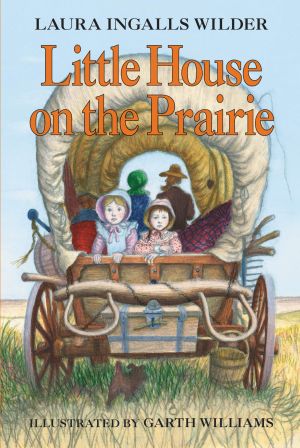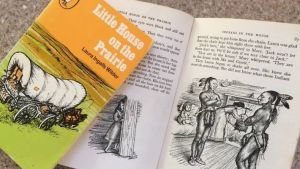Little House on the Prairie
Little House on the Prairie is an autobiographical children's novel by Laura Ingalls Wilder, distributed in 1935. It was the third novel distributed in the Little House series, continuing the first series Little House in the Big Woods, released in 1932, but not related to the second.[1] The story is about a family of five who moves to Kansas during the western settlement that drove away many American Indians from their land.
The “Little House” books were born of desperation. Laura, who by then was in her sixties, had lost everything. The success of her books worsens their mother-daughter relationship. Rose, daughter of Laura, grew up to become a famous writer and worked with her mother on the “Little House” series.[2]
Plot
The novel is about the Ingalls family who spent months in Kansas prairie around the town of Independence where Laura's father build a house in an Indian territory. During this time, the Ingalls face difficulty and troubles. They all fall ill from malaria[3], which was ascribed to breathing the night air or eating watermelon.[1] Having to live in Indian territory, American Indians are common sights to them but they are putting them on edge because they are afraid the Native Americans will be hostile toward them.
A year after the family arrives in Kansas, many Native Americans leave the area. Just as Pa is preparing farm fields to grow crops and a garden, he learns that US soldiers will be coming through the territory to remove white settlers rather than allowing them to claim land. He immediately packs up the house and reassembles the covered wagon, and the family moves on the next day, looking for a new place to call home.[4]
Controversy
A division of the American Library Association voted unanimously Saturday to strip Laura Ingalls Wilder's name from a major children's literature award over concerns about how the author referred to Native Americans and blacks. While many of the Little House books became widely read, critics said her work included many stereotypical and reductive depictions of Native Americans and people of color.[5] The book refers to black people as darkies and mentions that Native Americans are not people.
In the original book, chapter 15, a paragraph tells how Laura describes black people;
“Then the doctor came. And he was the black man. Laura had never seen a black man before and she could not take her eyes off Dr. Tan. He was so very black. She would have been afraid of him if she had not liked him so much. He smiled at her with all his white teeth. He talked with Pa and Ma, and laughed a rolling, jolly laugh. They all wanted him to stay longer, but he had to hurry away.”
The references to Native Americans and other people of color in the books are troubling. Characters express their hatred for the people they were dispossessing while a description of a minstrel show concludes: “When the five darkies suddenly raced down the aisle and were gone, everyone was weak from excitement and laughing.”[6]
In 1935's Little House on the Prairie, Wilder described one setting as a place where "there were no people. Only Indians lived there." That description was changed in later editions of the book. And multiple characters in the Little House series intone that "the only good Indian is a dead Indian."[5]
References
- ↑ 1.0 1.1 https://en.wikipedia.org/wiki/Little_House_on_the_Prairie_(novel)
- ↑ https://nypost.com/2018/08/07/the-real-story-behind-the-little-house-on-the-prairie-controversy/
- ↑ History of Malaria Archived August 29, 2008, at the Wayback Machine
- ↑ https://www.supersummary.com/little-house-on-the-prairie/summary/
- ↑ 5.0 5.1 https://www.npr.org/2018/06/25/623184440/little-house-on-the-controversy-laura-ingalls-wilders-name-removed-from-book-awa
- ↑ https://www.atlasobscura.com/articles/what-did-they-eat-little-house-on-the-prairie

